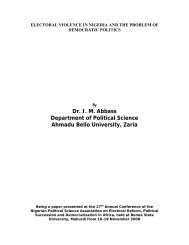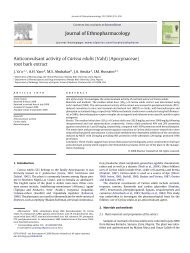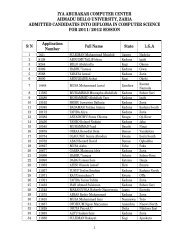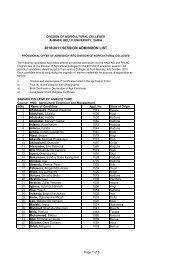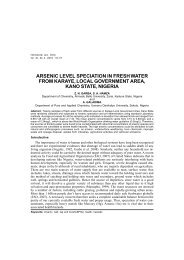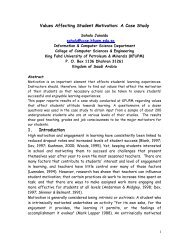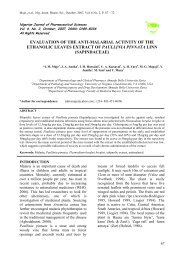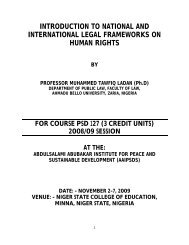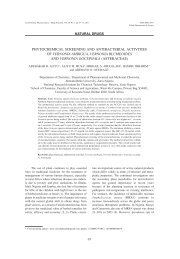Study of the Effect of Aqueous Hibiscus Sabdariffa Linn Seed Extract ...
Study of the Effect of Aqueous Hibiscus Sabdariffa Linn Seed Extract ...
Study of the Effect of Aqueous Hibiscus Sabdariffa Linn Seed Extract ...
You also want an ePaper? Increase the reach of your titles
YUMPU automatically turns print PDFs into web optimized ePapers that Google loves.
581 Okasha. M. A. M, Abubakar. M. S and Bako. I. G<br />
Figure 3: Showing serum prolactin level <strong>of</strong> control, extract-treated and extract plus dopamine-treated groups<br />
in lactating Albino rats.<br />
4. Discussion<br />
Human breast milk is widely accepted to be <strong>the</strong> optimal source <strong>of</strong> nutrition for <strong>the</strong> newborn infant,<br />
containing all <strong>the</strong> proteins, lipids, carbohydrates, micronutrients and trace elements required for<br />
growth, development and immune protection (Ostrom, 1990). The results <strong>of</strong> <strong>the</strong> present study reported<br />
that, <strong>the</strong> aqueous seed extract <strong>of</strong> <strong>Hibiscus</strong> sabdariffa l. produced an appreciable increase in serum<br />
prolactin level when compared to <strong>the</strong> control in a dose-dependent manner. The seed extract <strong>of</strong> H.<br />
sabdariffa l. exhibited a lactogenic activity by increasing <strong>the</strong> serum prolactin level in lactating rats. The<br />
lactogenic activity displayed by <strong>the</strong> largest dose <strong>of</strong> aqueous seed extract (1600mgkg -1 ) when compared<br />
with that <strong>of</strong> metoclopramide (commercial hyperprolactinemia-inducing agent) showed no significant<br />
statistical difference in serum prolactin level. This means that both <strong>of</strong> metoclopramide and <strong>the</strong> largest<br />
extract dose have similar effect on serum prolactin level in lactating female rats as shown in table (2)<br />
and fig. (2). This implies that <strong>the</strong> potency <strong>of</strong> <strong>the</strong> extract at largest dose is almost <strong>the</strong> same with<br />
metoclopramide. Lactogenic effect <strong>of</strong> herbs and seed has been reported in o<strong>the</strong>r plants (Asparagus<br />
racemosus, fennel seed, Grape sap, milk thistle and goat’s rue) (Garcia and Adams, 2005; Goyal et al.,<br />
2003; Oketch-Rabah, 1998; Narendranath et al., 1986; Sholapurkar, 1986). The presence <strong>of</strong> steroidal<br />
saponins and sapogenins constituents contributes in <strong>the</strong> lactogenic effect <strong>of</strong> Asparagus racemosus<br />
(Goyal et al., 2003; Oketch-Rabah, 1998). In <strong>the</strong> same vein <strong>the</strong> presences <strong>of</strong> saponins, tannins,<br />
alkaloids and flavonoids in <strong>Hibiscus</strong> sabdariffa l. may be responsible for <strong>the</strong> increase in serum<br />
prolactin level. The mechanism through which <strong>Hibiscus</strong> sabdariffa l. exerted its effect might be by<br />
dopaminergic influence, as dopamine receptor antagonist, since dopamine blocked <strong>the</strong> largest dose<br />
effect as shown in table (3) and fig. (3). Besides, we could not find any previous studies on <strong>Hibiscus</strong><br />
sabdariffa l. extract to be tested as galactogogue which can contrast or confirm <strong>the</strong> results <strong>of</strong> our<br />
studies in this field <strong>of</strong> research work. The plant extract has characterized by a very low degree <strong>of</strong><br />
toxicity. The acute toxicity LD 50 <strong>of</strong> <strong>Hibiscus</strong> sabdariffa l. seed extract in albino rats was found to be<br />
above 5000 mgkg -1 according to <strong>the</strong> method <strong>of</strong> Lorke (1983). Sub-chronic toxicity studies <strong>of</strong> <strong>Hibiscus</strong><br />
sabdariffa l. extract have been done by accessing <strong>the</strong> liver enzymes and kidney metabolites as<br />
indicators for liver and renal function tests. The liver enzymes and kidney metabolites were found to be<br />
within <strong>the</strong> normal ranges when compared to control.



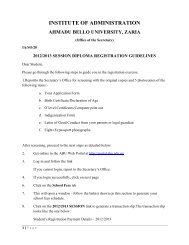
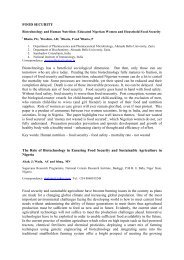

![Full Paper [PDF]](https://img.yumpu.com/49740055/1/184x260/full-paper-pdf.jpg?quality=85)
